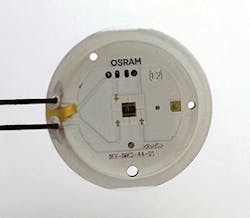Necessity may be the mother of invention, but lately “innovation” seems to come from “possibility,” from the fact that someone, somewhere asked, “What if …?”
There is no crying need in the world for a machine that combines diecasting techniques with plastic injection molding, and yet a cooperative research effort has developed that new possibility. Working with Osram, the Munich-based lighting manufacturer, researchers at Germany’s Institute of Plastics Processing (IKV) at RWTH Aachen University successfully cast plastic and metal together on a single machine and in a single process step.
It’s a design based on a standard injection molding machine updated with a newly developed metal diecasting unit. This new machine is capable, therefore, of producing plastic housings for LED lights already fitted with the required conductive tracks. It shortens the production time for LED lights, but according to the developers it also opens up new possibilities in product design.
It is those possibilities — the developers list consumer electronics, flashlights and hand tools with integral lighting — that provide the further explanation to the “what if?” question.
To optimize manufacturing of such items, IKV has been working on the development of a new hybrid processing technology called “Integrated metal/plastic injection molding” (IMKS). This process allows manufacturing of electrically conductive plastic/metal components on a single machine in an injection molding tool without any upstream or downstream processing steps.
In the joint-development project involving Osram, IKV, KraussMaffei (a developer of injection molding machinery), and the Krallmann Group (a producer of injection molded plastic components), have developed a production process they describe as “industrially feasible” for plastic/metal hybrid parts for electronic applications. The main objective for this research team was to evolve a strategy for integrating a low-melting solder into visible components.
One particular area of their focus was the contacts between the electrical inserts and the different contact surfaces and geometries.
Based on their investigation of possible flow-channel geometries and flow lengths, the researchers developed a demonstrator part that highlights the potential of the IMKS technology.
Their findings derived from the contacting of electronic components in the injection molding tool have persuaded the project partners to further develop this innovative technology. The next stage calls for Osram to apply the process in series production, and both Osram and IKV indicate their ongoing cooperation will deliver further technological progress.










